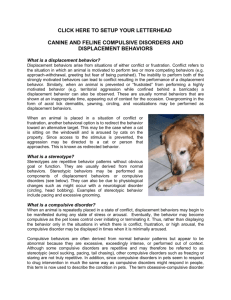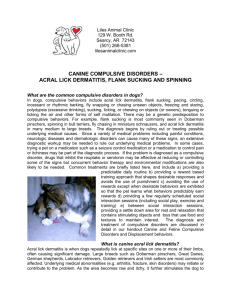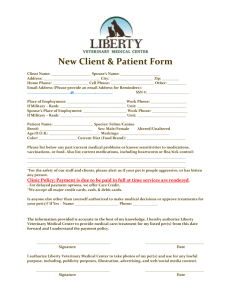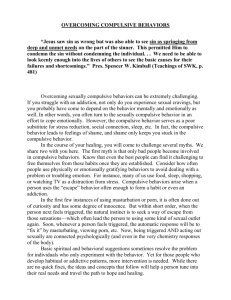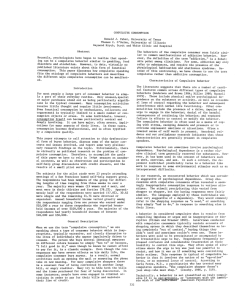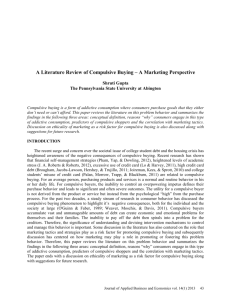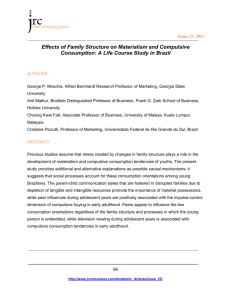compulsive_disorders-dogs
advertisement
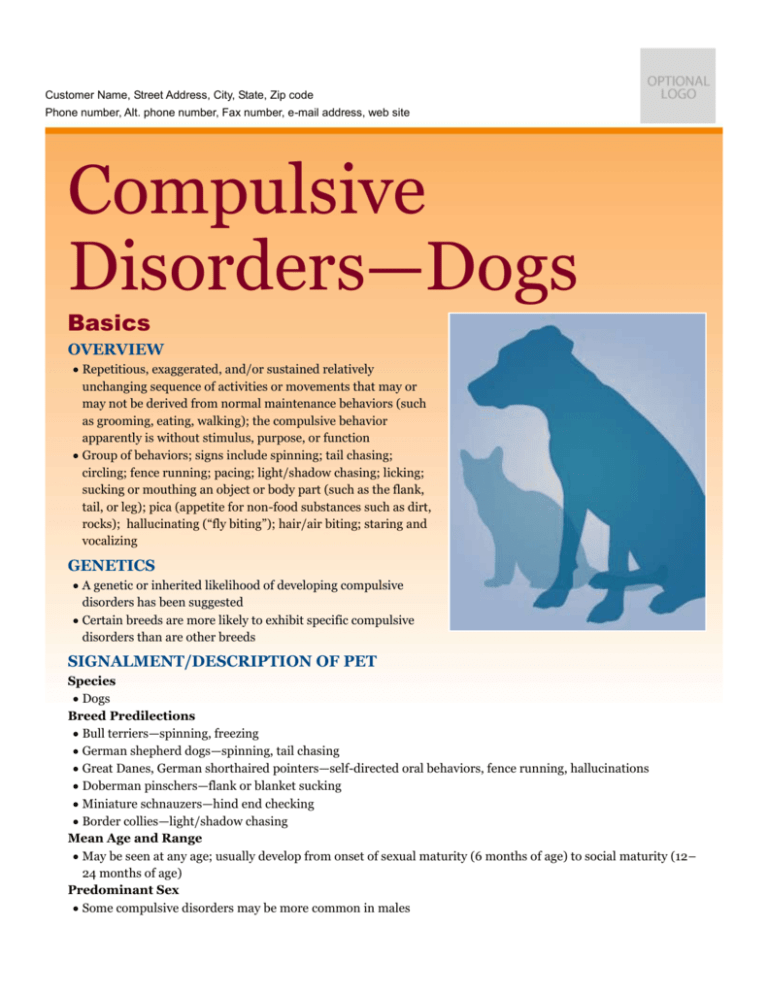
Customer Name, Street Address, City, State, Zip code Phone number, Alt. phone number, Fax number, e-mail address, web site Compulsive Disorders—Dogs Basics OVERVIEW • Repetitious, exaggerated, and/or sustained relatively unchanging sequence of activities or movements that may or may not be derived from normal maintenance behaviors (such as grooming, eating, walking); the compulsive behavior apparently is without stimulus, purpose, or function • Group of behaviors; signs include spinning; tail chasing; circling; fence running; pacing; light/shadow chasing; licking; sucking or mouthing an object or body part (such as the flank, tail, or leg); pica (appetite for non-food substances such as dirt, rocks); hallucinating (“fly biting”); hair/air biting; staring and vocalizing GENETICS • A genetic or inherited likelihood of developing compulsive disorders has been suggested • Certain breeds are more likely to exhibit specific compulsive disorders than are other breeds SIGNALMENT/DESCRIPTION OF PET Species • Dogs Breed Predilections • Bull terriers—spinning, freezing • German shepherd dogs—spinning, tail chasing • Great Danes, German shorthaired pointers—self-directed oral behaviors, fence running, hallucinations • Doberman pinschers—flank or blanket sucking • Miniature schnauzers—hind end checking • Border collies—light/shadow chasing Mean Age and Range • May be seen at any age; usually develop from onset of sexual maturity (6 months of age) to social maturity (12– 24 months of age) Predominant Sex • Some compulsive disorders may be more common in males SIGNS/OBSERVED CHANGES IN THE PET • Wide variety of behaviors possible; behaviors may be repetitive or static (for example, “freezing” in place) • Signs may or may not be observed during physical examination • May see self-induced injuries • May have history or other signs of anxiety or other behavioral issues (such as separation anxiety, fear, aggression) • Videotape dogs in all circumstances where the client sees the behavior; a pattern may become clear; the videotape of the behavior will aid diagnosis and treatment planning • Behavior first shown as part of play or in situations of high arousal or stress; eventually occurs in numerous contexts without identifiable triggers (triggers are situations or things to which the dog reacts, leading to compulsive behaviors) • Certain compulsive disorder behaviors are expressed in situations with little to no external stimulation or evidence of arousal (for example, blanket sucking) • Compulsive behaviors occur whether or not the owner is present; if pet is punished frequently for behavior, it may avoid detection when owner is home • Hallmarks—behavior is ritualized, often exaggerated, and with time increases in frequency, intensity, and duration • May be difficult or impossible to interrupt behavior (even with physical restraint) • Behavior may interfere with normal functioning, such as eating, sleeping, and normal social interactions CAUSES • No direct causes RISK FACTORS • Stress secondary to environment (for example, kenneling—spinning), management, illness, other • Owner/environment reinforcement of the behavior • Illness or pain may increase a dog's anxieties or may be primary cause of behavior • Sensory abnormalities (such as decreased or abnormal vision) may contribute Treatment HEALTH CARE • Not all repetitive behavior is abnormal; it may represent a beneficial coping mechanism; if not harmful nor interfering with normal functioning, health, or the human-animal bond, treatment may not be necessary • Usually outpatient • Inpatient—pets with severe self-mutilation and self-induced injury; pets that must be protected from the environment until the medications reach effective levels (may require days to weeks of therapy); hospitalization may increase compulsive behaviors • Sedation may be necessary in severe cases; only a stop-gap measure, but necessary if serious and acute mutilation involved • Treat associated physical conditions • Treat with a combination of environmental modification, behavior modification, and medication • Medication—implement early; reduction of anxiety aids behavioral therapy • Environmental modification—reduce stress and anxiety; identify and remove triggers (triggers are situations or things to which the dog reacts, leading to compulsive behaviors) and/or begin desensitization and counterconditioning exercises • Punishment should be avoided; may make the behavior worse and lead to the pet being more secretive • Provide structured, consistent interactions and routines; provide sufficient exercise, enrichment, and mental stimulation • Behavior modification—teach the pet to relax in a variety of settings; also teach a calm, desirable behavior to substitute for the compulsive one • Teach the pet to lie down with its head outstretched in response to “Head down”; in some cases, the use of a head collar (such as Gentle Leader, Halti) left on the dog will allow the owner to use gentle physical guidance in conjunction with verbal encouragement/cues to interrupt the compulsive behavior and to redirect it more effectively • Identify situations in which compulsive behavior occurs and attempt to preempt them by engaging pet in a desirable activity; if compulsive behavior occurs, disrupt it immediately and redirect the pet to an alternative behavior and reward to enforce the appropriate behavior ACTIVITY • Depends on compulsive behavior exhibited and individual pet • Increase exercise DIET • Depends on compulsive behavior exhibited and individual pet Medications Medications presented in this section are intended to provide general information about possible treatment. The treatment for a particular condition may evolve as medical advances are made; therefore, the medications should not be considered as all inclusive • Selective serotonin reuptake inhibitors (SSRIs) and tricyclic antidepressants (TCAs) increase serotonin levels in the central nervous system • SSRIs—fluoxetine, sertraline, paroxetine • TCAs—clomipramine, amitripyline • Synthetic pheromones (for example, Dog Appeasing Pheromone [DAP]) may decrease anxiety • L-theanine may reduce anxiety • Selegiline Follow-Up Care PATIENT MONITORING • Monitor behaviors via weekly videotaping and written logs; will provide unbiased assessments of change and help with alterations in treatment plans • Complete blood count, biochemistry profile, thyroid (T4) hormone levels, and urinalysis—semiannually to yearly if the pet is on long-term (chronic) treatment; adjust dosages accordingly • Medications may take 8–12 weeks or longer to show an effect on the target behavior—the first sign of effectiveness of the medication may be change in duration or frequency of bouts rather than total cessation of the undesired behaviors • Relapses can be common during stressful situations PREVENTIONS AND AVOIDANCE • Monitor dogs that are related to dogs having compulsive disorders to allow early recognition of abnormal behavior and prompt intervention EXPECTED COURSE AND PROGNOSIS • If left untreated, these conditions almost always progress • Approximately 50% reduction in compulsive behavior is seen in approximately two-thirds of cases with appropriate medication and environmental and behavioral modification Key Points • Compulsive disorder is unlikely to be cured; usually requires lifelong management • Recognize all body language and behaviors associated with anxiety • Compulsive behaviors occur whether or not the owner is present; if pet is punished frequently for behavior, it may avoid detection when owner is home • Hallmarks—behavior is ritualized, often exaggerated, and with time increases in frequency, intensity, and duration • May be difficult or impossible to interrupt behavior (even with physical restraint) • Behavior may interfere with normal functioning, such as eating, sleeping, and normal social interactions Enter notes here Blackwell's Five-Minute Veterinary Consult: Canine and Feline, Fifth Edition, Larry P. Tilley and Francis W.K. Smith, Jr. © 2011 John Wiley & Sons, Inc.


